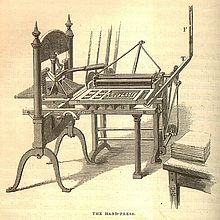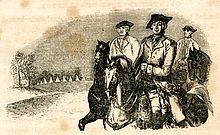Part I: Early Obstacles to the Rise of Illustrated Histories
The earliest attempts at producing illustrated histories in the nineteenth century were fumbling and largely unsuccessful. The synergies between artists and historians or historians and publishers proved hard to accomplish due to limitations in the reproduction of texts and images.
Finding Enough History to Illustrate
With respect to texts, there was an embarrassing lack of American history for historians to narrate. In comparison with most European nations, the United States was “unhistoried,” a condition that made attempts at creating a grand “master” narrative seem shallow and puerile. The greatest challenge European historians faced was how to select among myriads of historically significant episodes over centuries of experience, whereas American historians were accused of investing minor episodes with false significance in a sad effort to legitimize themselves and their work. No matter how hard one strained to create a sense of the epic tradition in America (one suitable for pictorial illustration, for instance), the Battle of Bunker Hill was not the Battle of Hastings, and the defeat of the British fleet on Lake Erie during the War of 1812 did not approximate the demise of the Spanish Armada.
 Enlarge
Enlarge
Book publishing was still in its infancy as well, and manufacturing and distribution costs were so prohibitive that even if enough historical material had been available to support a history book industry, the purchase of such works by the general public was simply out of the question for most. Manually operated presses had not given way to more efficient horse- and team-driven equipment yet, and the inking process was still laboriously performed by hand, awaiting the invention of rollers and cylindrical presses. [Image 3] Booksellers faced enormous obstacles in circulating their volumes extensively as well, since the geography of the United States in the first third of the nineteenth century did not lend itself readily to mass distribution; the population was large and scattered widely, while the urban centers were small and their markets easily saturated. Poor roads, unnavigable river systems and inadequate bridges made it difficult for book dealers to hawk their wares or to foster a “climate of readership,” and it was not until the internal improvements of the 1820s and 1830s emerged as well as a nascent railway system that transportation was convenient and efficient enough to make wider circulation of books possible.[2]
Reproducing Images of the Past with Fidelity
With regard to visual materials and the history of book-making, the challenge for publishers on both sides of the Atlantic was to incorporate pictorial images into their texts with fidelity to the intentions of the original image maker. On the one hand, there was no adequate mechanism for the simultaneous integration of words and images on the printed page. Publishers were reliant on inconsistent woodcut technologies by which engravers transferred artists’ original drawings onto wood blocks. Working generally on the end grain of the block, an engraver carved away extraneous portions of wood not identified by the artist as significant, leaving a copy of the original picture in relief. [Image 4] The resulting engraved block was then set up in a press, where it was inked, pressed, and cleaned in succession, and where, if its structural integrity was not compromised, it could be used to generate multiple impressions.[3]
Part I: Early Obstacles to the Rise of Illustrated Histories
Click once to view this video on wood engraving. Video only; no sound. This short video illustrates how wood engraver John Steins engraves an end-grain boxwood block with a graver and the aid of an engraver’s pillow. View and comment at YouTube.
Original woodcut illustrations were often produced on special presses, requiring a publisher to operate multiple printing machines for the production of a single book. This was an expensive prospect, one that obligated publishers to employ technicians trained in multiple areas of printing competency. The continuing “intrusion of [the] intermediary hand” of the engraver also meant that inaccuracies of translation frequently resulted from the process of reproducing images, and these inaccuracies discouraged many artists from working in the illustrated book market.[4] The oft-quoted complaints of Pre-Raphaelite painter Dante Gabriel Rossetti typified the reaction of many artists toward careless translators of visual images: “[T]hese engravers! What ministers of wrath!” Rossetti complained. “Your drawing comes to them. . . delicately“ but is shortly “hewn in pieces before the Lord Hurry.” One such butcher-engraver had rendered Rossetti “an invalid,” the painter complained, by dismembering one of his drawings and then “performing his cannibalistic jig [the engraver’s signature] in the corner.”[5]
 Enlarge
Enlarge
Even when artists drew directly on the block themselves, the distortions of the graver so altered their intentions for an image that many refused to sign their work. Frequently it was the engraver rather than the artist whose name appeared etched in the corner of an illustration, and engravers often received more to “cut a drawing” than did the artist who sketched it.[6] For these and other reasons, many fine artists continued to view pictorial illustration “as irrelevant to the serious aims of art” [Image 5][7]
Constrained by costs, publishers of pictorial histories in the 1830s and 1840s advanced only modest programs for pictorializing texts at first, illustrations serving mainly an unambitious decorative function. Publishers could rarely afford to be interested in the quality of the images that embellished such works, and they often elected primitive and unadorned images at reduced costs over sophisticated and beautiful illustrations for which no adequate remuneration in the form of sales was likely. Consequently, pictures in early illustrated histories generally do not compete with texts; they do not challenge, engage, or subvert the ideas elaborated in the narrative. Instead, they “represent” those ideas in a denotative sense, helping to reiterate visually the literary themes of the story. By using pictures in this limited way, by respecting cherished assumptions about the superiority of the word to the image, that is, the stigma of illustration as “deceptive illusionism” was reduced.[8] “Great care has been taken to secure accuracy” in all illustrations, noted a typical disclaimer in one pictorial history, “so that they may not convey false instruction.”[9]

